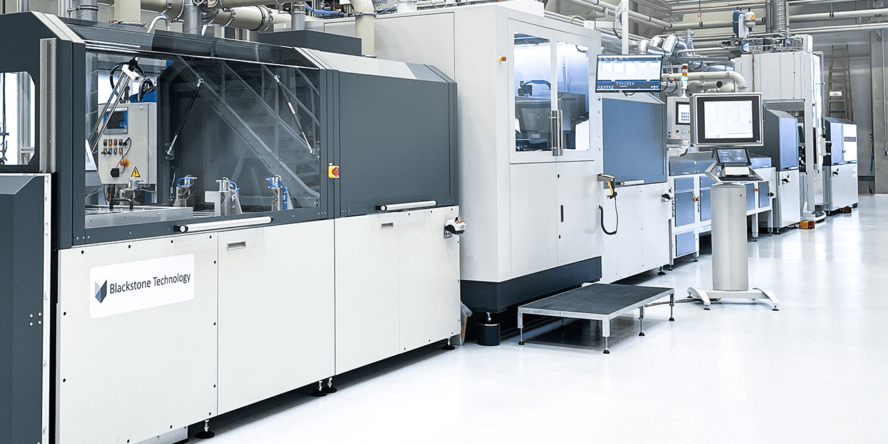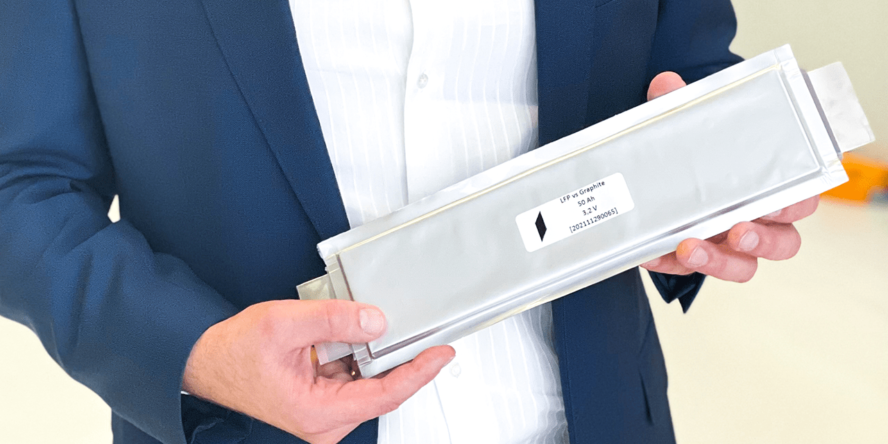Blackstone Resources, a Swiss investment firm focused on battery technology, has announced the series production of its 3D printed battery cells at its new manufacturing plant in Döbeln, Germany.
With the ultimate aim of tackling the electric vehicle market, the firm set up its own German research and development subsidiary, Blackstone Technology, in 2019.
The company has spent the past two years developing and refining its lithium-ion battery 3D printing technology, having now hosted an online event launching its first large-scale production facility.

3D printing batteries with Blackstone
According to Blackstone, the liquid electrolyte battery production lines of today tend to be very specialized, meaning they can only manufacture one type of battery at a time. The energy-intensive process is often a very expensive one, and uses dangerous solvents as raw materials for electrodes.
On the other hand, Blackstone’s ‘Thick Layer Technology’ is intended as a much more flexible and cost-effective alternative, covering a wider range of cell formats while using environmentally friendly materials. Owing to the dynamic nature of the 3D printing process, Blackstone states that it can even tailor the size and shape of the cells to the customer’s requirements.
The process reportedly allows the firm to achieve energy density improvements of around 20% when compared to traditionally manufactured counterparts, offering densities of up to 220 Wh/kg. Additional claims include space savings of up to 15%, material cost savings of 20€/kWh, and a 23% lower energy consumption in production.
Ulrich Ernst, founder and CEO of Blackstone Resources, adds, “The patented process relies on an environmentally friendly, purely water-based process and reduces waste materials by 50%. In this way, we are making an important and sustainable contribution to the transport turnaround and in the fight against climate change.”
While Blackstone is starting with lithium-ion cells, the company believes its technology will be applicable to other cell chemistries too. This includes solid-state ones, which should increase energy density by another 70%.

Shooting for 10GWh production capacity
Blackstone Technology has set its initial target annual production capacity at 500 MWh, which it expects to reach by the end of next year. Although a timeline has not been set, phase two of the growth plan will target 5GWh per year, and phase three will eventually aim for over 10GWh.
According to Holger Gritzka, managing director of Blackstone Technology, the firm’s long-term goal is to produce battery cells every second: “The vision – with a single machine park, we print cells in different shapes, different electrodes, and electrolyte materials quickly and cost-effectively on a large scale.”
To enable this goal, the company will expand its Döbeln employee count from 14 to 38 in the next year, drawing in workers from neighboring cities such as Leipzig, Chemnitz, and Dresden.
Blackstone is already working on developing a bipolar battery design with its partner Liovolt, a Germany-based energy firm. The lithium-ion cell will comprise several stacked electrodes connected in series, whereby the cathode and anode materials will be placed on a common electrode carrier.
Serhat Yilmaz, CMO at Blackstone Resources, says, “The next step is now to develop a battery system with our partner ecovolta, and with Voith SE and Orten Electric Trucks we are aiming for a project to equip electrified e-buses with our battery technology.”
The 3D printing of energy storage devices is very much a niche field, with much of the work still in the research phase. Back in October, researchers at the Swiss Federal Laboratories for Materials Science and Technology (EMPA) used 3D printing to create a sustainable new class of supercapacitor. The fully-3D printed battery, composed of a flexible cellulose and glycerol substrate, patterned with a conductive carbon and graphite-laden ink, is able to withstand thousands of charging cycles while maintaining its capacity.
Elsewhere, Sakuu Corporation (formerly KeraCel), a specialist in 3D printed energy storage devices, recently commenced the construction of a new pilot facility for the production of its own 3D printed solid-state batteries. Expected to complete by the start of next year, the pilot line will reportedly be able to produce up to 2.5 MWh of solid-state batteries every year.
Subscribe to the 3D Printing Industry newsletter for the latest news in additive manufacturing. You can also stay connected by following us on Twitter, liking us on Facebook, and tuning into the 3D Printing Industry YouTube Channel.
Looking for a career in additive manufacturing? Visit 3D Printing Jobs for a selection of roles in the industry.
Featured image shows a lithium-ion battery 3D printed by Blackstone Technology. Photo via Blackstone Technology.



